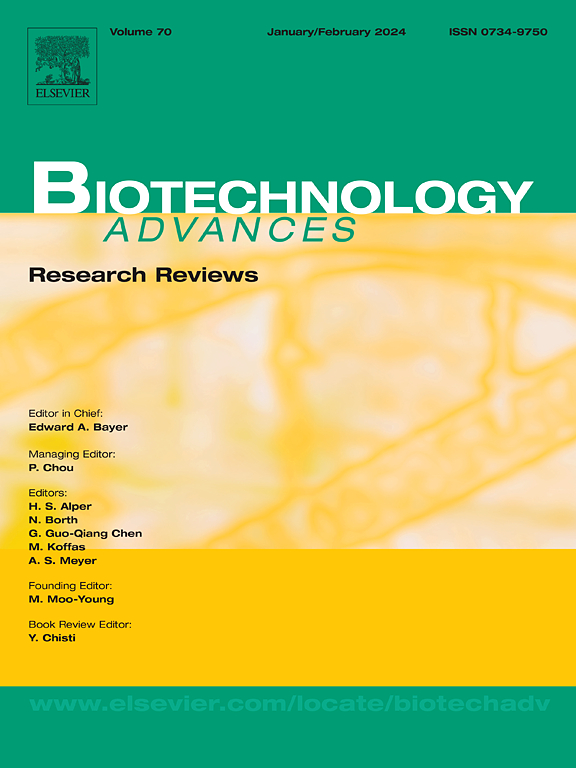细菌-藻类在固碳中的协同作用:分子机制、生态动力学和生物技术创新。
IF 12.5
1区 工程技术
Q1 BIOTECHNOLOGY & APPLIED MICROBIOLOGY
引用次数: 0
摘要
不断上升的大气二氧化碳水平需要创新的策略来增加碳固存。细菌-藻类的相互作用是海洋和淡水碳汇的关键驱动因素,但尚未得到充分的探索,它涉及多种机制,可以放大二氧化碳的固定和长期储存。本文系统地介绍了微藻(如小球藻和三角褐指藻)和大型藻(如大囊藻和海带藻)在固碳方面的协同作用。这些影响包括(1)分子水平调控(如通过n -酰基-高丝氨酸内酯(AHLs)和水平基因转移进行的信号转导),(2)顽固性溶解有机碳(RDOC)形成的生态促进,以及(3)生物技术在废水处理和生物能源生产中的应用。我们强调,微生物串扰使藻类光合作用增加了20- 40% %,并贡献了18.9 %的海带来源的RDOC储存。此外,整合藻-细菌共生的工程系统实现了超过80% %的养分去除和22-35 %的CO₂固定效率提高(与无氧藻系统相比),证明了它们在减缓气候变化和循环经济中的双重作用。这篇综述首次将分子机制(如群体感应)、生态碳转化过程(如RDOC的形成)以及在合成生物学中的应用(如crispr工程财团)整合到一个统一的框架中。在此基础上,提出了“微生物相互作用网络优化”的碳汇增强策略。然而,可扩展性的挑战仍然存在,包括光生物反应器的光限制和合成财团的生态风险。通过将微生物生态学与合成生物学相结合,这项工作为利用细菌-藻类协同作用实现碳中和提供了路线图。本文章由计算机程序翻译,如有差异,请以英文原文为准。
Bacteria–algae synergy in carbon sequestration: Molecular mechanisms, ecological dynamics, and biotechnological innovations
Rising atmospheric CO₂ levels require innovative strategies to increase carbon sequestration. Bacteria–algae interactions, as pivotal yet underexplored drivers of marine and freshwater carbon sinks, involve multiple mechanisms that amplify CO₂ fixation and long-term storage. This review systematically describes the synergistic effects of bacteria–algae consortia spanning both microalgae (e.g., Chlorella vulgaris and Phaeodactylum tricornutum) and macroalgae (e.g., Macrocystis and Laminaria) on carbon sequestration. These effects include (1) molecular-level regulation (e.g., signal transduction via N-acyl-homoserine lactones (AHLs), and horizontal gene transfer), (2) ecological facilitation of recalcitrant dissolved organic carbon (RDOC) formation, and (3) biotechnological applications in wastewater treatment and bioenergy production. We highlight that microbial crosstalk increases algal photosynthesis by 20–40 % and contributes to 18.9 % of kelp-derived RDOC storage. Furthermore, engineered systems integrating algal–bacterial symbiosis achieve greater than 80 % nutrient removal and a 22–35 % increase in CO₂ fixation efficiency (compared with axenic algal systems), demonstrating their dual role in climate mitigation and a circular economy. This review is the first to integrate molecular mechanisms (e.g., quorum sensing), ecological carbon transformation processes (e.g., the formation of RDOC), and applications in synthetic biology (e.g., CRISPR-engineered consortia) into a unified framework. Moreover, the novel strategy “microbial interaction network optimization” for enhancing carbon sinks is proposed. However, scalability challenges persist, including light limitations in photobioreactors and the ecological risks of synthetic consortia. By bridging microbial ecology with synthetic biology, this work provides a roadmap for harnessing bacteria–algae synergy to achieve carbon neutrality.
求助全文
通过发布文献求助,成功后即可免费获取论文全文。
去求助
来源期刊

Biotechnology advances
工程技术-生物工程与应用微生物
CiteScore
25.50
自引率
2.50%
发文量
167
审稿时长
37 days
期刊介绍:
Biotechnology Advances is a comprehensive review journal that covers all aspects of the multidisciplinary field of biotechnology. The journal focuses on biotechnology principles and their applications in various industries, agriculture, medicine, environmental concerns, and regulatory issues. It publishes authoritative articles that highlight current developments and future trends in the field of biotechnology. The journal invites submissions of manuscripts that are relevant and appropriate. It targets a wide audience, including scientists, engineers, students, instructors, researchers, practitioners, managers, governments, and other stakeholders in the field. Additionally, special issues are published based on selected presentations from recent relevant conferences in collaboration with the organizations hosting those conferences.
 求助内容:
求助内容: 应助结果提醒方式:
应助结果提醒方式:


